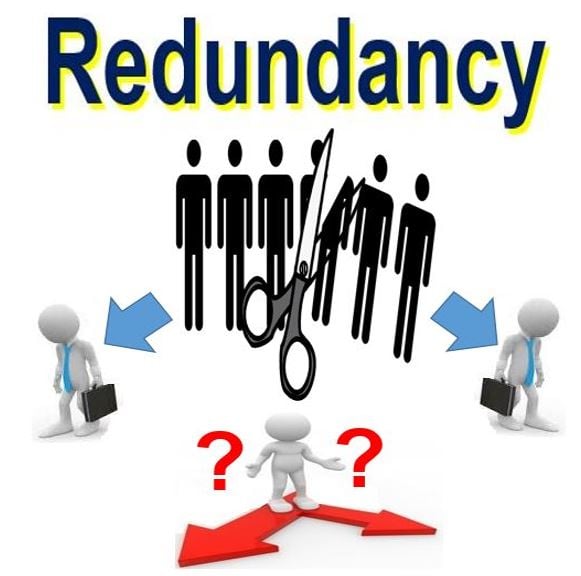What Happens to Redundancy If Company Goes Bust? An Overview to Your Rights
What Happens to Redundancy If Company Goes Bust? An Overview to Your Rights
Blog Article
Discovering the Operational Characteristics of Company Redundancy and Its Long-Term Sustainability

Redundancy Methods for Company Continuity
In order to guarantee uninterrupted operations, companies have to execute reliable redundancy methods for service connection. Redundancy in this context describes the duplication of important elements or features within a system to reduce the effect of possible failings. By incorporating redundancy approaches, organizations can enhance their durability versus disruptions brought on by various elements such as all-natural disasters, devices failings, or cyber-attacks.
One usual redundancy strategy is the implementation of back-up systems and information storage space solutions. This involves developing duplicates of crucial information and systems that can be turned on in instance of a main system failing. Additionally, organizations can develop repetitive communication channels and source of power to preserve connectivity and operations throughout unanticipated occasions.
Additionally, cross-training staff members to perform numerous functions within the firm can function as a valuable redundancy strategy. This guarantees that vital tasks can still be performed even if key employees are unavailable due to illness or various other reasons. Generally, efficient redundancy techniques are vital for companies to support operational connection and decrease the impact of prospective interruptions.
Effect of Redundancy on Business Resilience
Provided the important role redundancy approaches play in guaranteeing organization connection, exploring the impact of redundancy on business strength comes to be necessary for understanding the holistic operational dynamics of a business. Redundancy, when purposefully executed, can dramatically add to enhancing a company's resilience in the face of unanticipated obstacles.
In addition, redundancy can boost worker morale and self-confidence, recognizing that there are contingency plans in location to deal with unpredicted scenarios. This complacency can result in increased productivity and a more favorable workplace. In addition, redundancy can foster technology and creativity within an organization as workers feel encouraged to take calculated threats, recognizing that there is a safety web to support them in situation of failing. Overall, the impact of redundancy on organizational durability is extensive, forming the lasting sustainability and success of a firm.
Stabilizing Efficiency and Flexibility in Redundancy
Attaining an unified equilibrium in between functional efficiency and flexible adaptability is an essential difficulty in the critical release of redundancy within organizations. Effective procedures are crucial for maintaining efficiency and cost-effectiveness, ensuring that sources are made use of ideally. Nevertheless, extreme emphasis on performance alone can result in rigidity, making it tough for organizations to adjust to unanticipated modifications or challenges. On the various other hand, versatility allows organizations to react nimbly to progressing scenarios, cultivating development and durability. Yet, excessive flexibility without a strong functional structure can lead to inefficiencies and inconsistency.
To balance effectiveness and adaptability in redundancy preparation, companies need to carefully evaluate their operational requirements, market characteristics, and critical goals. Implementing lean practices can enhance effectiveness by enhancing procedures and getting rid of waste, while cultivating a culture of versatility and continual improvement can improve flexibility. Furthermore, investing in cross-training programs and robust interaction networks can assist cultivate a versatile labor force efficient in managing varied tasks throughout periods of change. Eventually, locating the right balance between effectiveness and adaptability is essential for developing a lasting and durable company in the face of uncertainty.
Long-Term Sustainability Via Redundancy Preparation
To make certain long-lasting practicality and security, organizations need to strategically straighten their redundancy planning with lasting sustainability goals, thereby harmonizing operational effectiveness with flexible adaptability. Long-term sustainability through redundancy planning includes even more than just short-term cost-cutting procedures. It calls for a thorough strategic method that prepares for future difficulties and chances. Companies ought to see redundancy not as a responsive solution to immediate issues yet as a proactive strategy for lasting success. By incorporating redundancy planning with sustainability objectives, companies can create a durable structure that can withstand different market variations and interior modifications.

Positive Measures for Lasting Company Workflow
How can business proactively enhance their operational sustainability for long-term success? Carrying browse around here out aggressive steps is important for companies aiming to make sure sustainable procedures.
Additionally, cultivating a culture of continual improvement and learning within the organization can boost flexibility to altering market conditions and customer needs. Motivating worker participation in decision-making procedures and providing chances for expert growth can boost morale, efficiency, and total performance. Developing clear goals, keeping an eye on key efficiency signs, and on a regular basis examining progress are important parts of proactive sustainability monitoring.
Teaming up with providers, clients, and various other stakeholders to promote sustainable methods throughout the supply chain can create a surge result of positive effect - redundancy pay if company goes bust. see this site By taking positive steps in the direction of operational sustainability, companies can build durability, drive development, and protect their long-term success in an ever-evolving business landscape
Verdict

In the realm of business management, the critical release of firm redundancy stands as a crucial yet complex method that demands a delicate balance in between operational performance and lasting stability. By studying the functional dynamics that underpin firm redundancy and reviewing its broader ramifications for business resilience and versatility, a nuanced understanding of just how redundancy methods can shape the future trajectory of a firm begins to unfold.Given the vital duty redundancy strategies play in making sure company connection, discovering the influence of redundancy on organizational resilience becomes necessary for recognizing the alternative functional characteristics of a company. On the whole, the influence of redundancy on organizational resilience is extensive, shaping the long-lasting sustainability and success of a firm.
In final thought, recognizing the operational dynamics of business redundancy is why not try these out vital for guaranteeing long-lasting sustainability.
Report this page